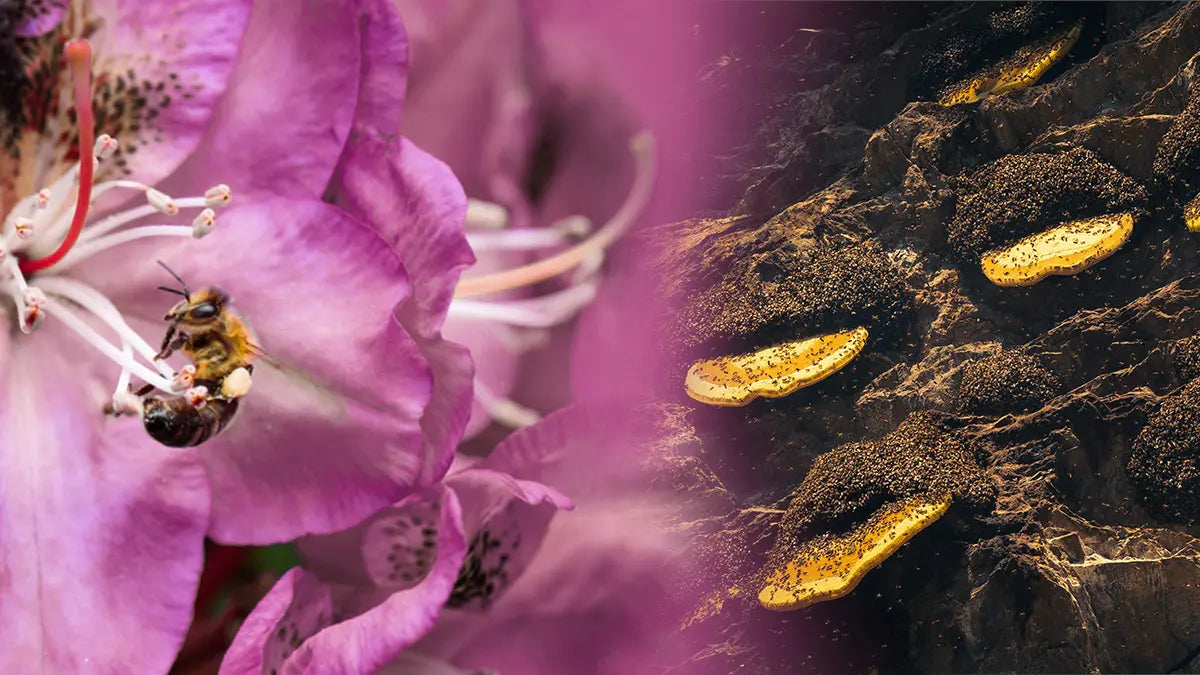Is Mad Honey Hallucinogenic and Psychoactive?
It is without doubt that Mad Honey is obviously hallucinogenic in nature and make you hallucinate if you fail to stay within the dosage limits. The Himalayan Cliff Honey has gained the name and fame of "Mad Honey" after displaying the hallucinogenic and psychoactive effects on humans. The psychoactive side effects of Grayanotoxin like hallucinations, dizziness and nausea was observed whenever a little more than recommended dose was ingested.
How Mad Honey becomes Hallucinogenic and Psychoactive?
Mad honey represents a special form of unique honey formed as the Giant Himalayan Honey Bees also known as Mad Bees or Apis Laboriosa (Scientificially) acquire nectar from rhododendron blossoms that contains the natural neurotoxin Grayanotoxins. It is not the bees that is Mad and produce honey, it is the bee that produce Mad Honey, hence known as Mad Honey Bee or Mad Bees. The toxins naturally found in these flowers pose no danger to bees yet generate a variety of neurogenic effects within human consumers of the honey. The consumption of mad honey containing this neurotoxin results in mild to severe hallucinogenic reactions together with dizziness and occasional severe effects to some victims.
The Unique Nectar Source: Rhododendron Flowers
The bees collect nectar for honey from natural rhododendron flower blossoms that grow across high-altitude locations of Turkey and Nepal. The high altitude regions have cold and harsh climate making the ordinary plants survival almost impossible. So, some coniferous and plants like Rhododendron, Azaleas are found at such regions.
The Rhododendron, Azaleas and some other wild flowering plants are found in acidic, moist soil conditions with cold climate. The Mad Bees in need of nectar collect nectar from whatever available in the region, where they find such flowers which contains Grayanotoxins. The collected nectar is stored and further processed by the bees to evaporate excess water from nectar which later turns into Honey. After harvesting the honey, it is consumed by humans as the Mad Honey that performs magic.
Grayanotoxin: The wizard that performs Magic in Mad Honey
What makes Mad Honey Hallucinogenic?
It's the Grayanotoxin that function as the primary hallucinogenic component which create both psychogenic effects along with toxic effects when consuming mad honey at higher doses.
As, we already know the nectar of particular rhododendron flower species contains grayanotoxins which work as natural neuro toxin. The Mad Honey bees can't filter this neurotoxin as they are unaffected by it. The evaporation process of honey by the Himalayan Giant Honey Bees also does not remove the grayanotoxin compounds which stays in the final product. Grayanotoxins once inside of human body disrupt nerve cell channels which affects the normal sodium ion movement into cells. The nervous system's disruption due to overdose of grayanotoxins induce side effects like dizziness in addition to nausea and blood pressure drop which can further escalate into hallucinations.
The hallucinogenic experience of Mad Honey has been linked with close association to the Hormesis. The low and minimal dosage intake is linked with the health benefits of Mad Honey including Mild euphoria, Pain Relief and Aphrodisiac effects. Considering the hallucinatory experience along with health benefits the Mad Honey is often called as Magic Honey.

The Journey of Mad Honey: From Flower to Hive
You might have seen the product Mad Honey and been wondering how the honey from hive reaches jar. Here is how.
Wild Bees into psychoactive Honey making, step by step process
The psychoactive honey making starts with the foraging of Himalayan Giant Bees. These bees starts collecting honey from Wild Flowers and Rhododendron Flowers. The process is almost similar to honey making process of the normal honey bees. Here’s a step-by-step explanation of how honey gets out of the honey stomach:
- Nectar Collection: Worker Wild bees collect nectar from Rhododendron and Azalea flowers using their long, tube-like tongues (proboscis) and store it in their honey stomach.
- Regurgitation: Once the honey stomach is full, the bee returns to the hive located at high cliffs. The bee then regurgitates the nectar through its mouth. Don't confuse regurgitation with vomiting. This process is not vomiting, it is a controlled release of the nectar from the honey stomach.
- Trophallaxis: The regurgitated nectar is passed mouth-to-mouth to other worker bees in the hive through a process called trophallaxis. This process allows the nectar to be mixed with enzymes that break down the complex sugars into simpler ones, which helps in the honey-making process.
- Enzyme Action: As the nectar is passed from bee to bee, enzymes (such as invertase) are added to it. These enzymes help convert the nectar into a more stable form, reducing its water content and making it more suitable for long-term storage.
- Storage in Honeycomb: After the nectar has been sufficiently processed, it is placed into the hexagonal cells of the honeycomb. Bees then fan their wings to evaporate excess water from the nectar, further concentrating it into honey.
- Sealing the Honeycomb: Once the honey is sufficiently concentrated, the bees seal the cells with wax to preserve it for future use and is ready for honey harvesting.
In summary, honey is transferred from the honey stomach to the hive through a series of regurgitation and enzyme actions, ultimately resulting in the production and storage of honey in the honeycomb. The psychoactive effects of mad honey appear when the honey made by Wild Bees is consumed. The psychoactive effects of Mad Honey is recorded in Humans as well as bears after the ingestion.
Harvesting of Psychoactive Honey Made by Mad Bees
Various cultures are involved in the harvesting of mad honey according to their own traditional methods. Professional beekeepers in the Turkish Black Sea coast operate by finding toxic rhododendron flowers followed by strategic hive placement to collect mad honey from these areas particularly around Trabzon.
Special tools and safety techniques are needed by the honey harvesters of Nepal to collect honey so they can ascend high mountain cliffs since large amounts of the dangerous substance can be fatal. There exist a unique connection between Himalayan Honey and Gurung ethnic community. To extract wild bee honey hives these people use traditional equipment for honey hunting. These collection methods serve cultural as well as rituals practices that cause users to administer limited amounts of mad honey for its intensified mind-altering properties and medicinal purposes. The process of harvesting mad honey operates under strict supervision which older people transmit to the next generation in both regions.
The Psychoactive Effects of Honey Made by Mad Bees
The consumption of Mad honey by humans causes mysterious responses. Small doses of consumption through mad honey will trigger dizziness and nausea together with hallucinations and mental state alterations. Wild honey consumption at moderate doses presents subtle effects and Mad Honey Euphoria but excessive consumption produces significant dangers. The side effects of Mad Honey can be seen as lowered blood pressure, slower heart beats and severe intoxication conditions.
The ancient history of Mad Honey has proved that it has played a vital role in psychoactive therapy within cultural settings because people used it as both medical treatment and recreational entertainment. The strong influence and unusual usage of mad honey has established it as an interesting and yet potentially dangerous substance at the same time.
The distinctive medical properties of mad honey have caused people to incorporate it into folk medicine, some used mad honey drinks at morning and some home remedies. The mad honey has been popular since ancient times for treating multiple natural conditions, some even used mad honey for meditation and natural wellness.
Conclusion
Bees develop mad honey by gathering nectar from rhododendron flowers which contain grayanotoxins. As the bees are tolerant to Grayanotoxin, they preserve the toxic compounds in the nectar as they produce honey inside their hive. Bee-produced toxins do not harm bee colonies yet they stay trapped inside the produced nectar during the transformation into hive honey. The rare hallucinogenic natural sweetener formed through this process shows psychoactive properties which affect human consciousness when eaten. The special production method of bees safely handling dangerous toxins results in honey availability that responds both to medical needs and social usage but demands careful consumption.
But before you give it a try, it is necessary to ask your own self is mad honey legal in your country or region?
FAQs:
How toxic are rhododendrons to humans?
Rhododendrons are moderately to highly toxic if ingested. Even small amounts of leaves, flowers, or nectar can cause nausea, dizziness, and heart irregularities due to grayanotoxin. Severe cases may require medical care.
What does grayanotoxin do to the body?
Grayanotoxin binds to sodium channels in cell membranes, keeping them activated. This disrupts nerve and muscle signaling, leading to symptoms like vomiting, low blood pressure, irregular heartbeat, and in rare cases, seizures.
Are rhododendrons toxic to the touch?
Touching rhododendron leaves or flowers is generally safe, but the plant’s parts are toxic if chewed or ingested. Sensitive skin may experience mild irritation from sap, though this is uncommon.
Do all rhododendrons have grayanotoxin?
Most rhododendrons, especially wild species, contain grayanotoxins in their nectar, leaves, and flowers. However, the concentration varies by species, season, and environment.
Is honey made from rhododendrons poisonous?
Yes, Honey from rhododendron nectar, known as “mad honey,” contains grayanotoxin. In small amounts, it may cause dizziness and euphoria; in larger doses, it can be toxic and require medical attention.





